
The author pits the Kimber Aegis Elite Ultra against the Springfield Armory Ronin to find the superior 3-inch 1911.
The 1911 pistol has been around for 112 years, and it seems like it becomes more popular all the time. Shooters cannot get enough of this ageless design, but the 1911—with its 5-inch barrel—is a big handgun that’s about 8.5 inches long and weighs almost 40 ounces.
If you like a 1911, there’s no denying the appeal of the more compact 3-inch versions for concealed carry, but I wanted to see just how well these modern, miniature 1911s would perform, and if they could be trusted. After all, a 6.75-inch pistol that only weighs about 26 ounces is a hell of a lot easier to carry than a full-size 1911.
I requested 3-inch barreled 1911s from Kimber and Springfield Armory so that I could test them for reliability and to get an idea of how much harder the lighter and more compact 1911s would be to shoot than a full-size 1911. That meant I also needed a full-size gun, so I also asked Springfield to send me a 5-inch 1911.
Kimber provided their Aegis Elite Ultra pistol with a 3-inch barrel, and Springfield Armory provided two of their Ronin pistols, one with a 3-inch barrel and one with a 5-inch barrel. All three were chambered for the 9mm Luger.
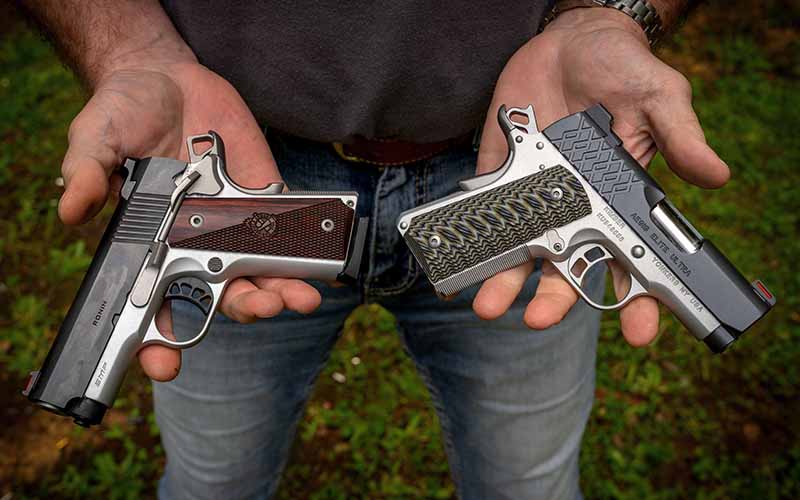
Fast Action Shooting
The first shooting test I conducted was a modified version of the famous El Prez Drill. For this drill, I placed three MGM full-size steel torso targets at 10 yards and spaced them about 15 feet apart. Starting with the pistol in a Galco Yaqui Slide holster, at the sound of the shot timer I drew and fired two shots at each target as fast as I could get hits. I ran this drill six times with each pistol to get an average time.
Admittedly, hitting a torso-sized target at 10 yards isn’t hard, but my focus here wasn’t on precision shooting, it was to see how hard these little guns were to control, how fast I could shoot them, and to see if they would run reliably. The drill would also highlight the difference between fast action shooting with a 3-inch, 25-ounce pistol, and one with a 5-inch barrel that weighed 39 ounces.
Between the two 3-inch pistols, I shot the best with the Kimber Aegis Ultra. My average time for six runs through the drill was 3.08 seconds. My average time with the 3-inch Springfield Armory Ronin was 3.21 seconds. Granted, the difference was small, but I think the thicker grips on the Kimber helped me hold onto the pistol a bit better and it’s why it performed 4 percent better. The average for all the runs with the two 3-inch guns was 3.14 seconds.
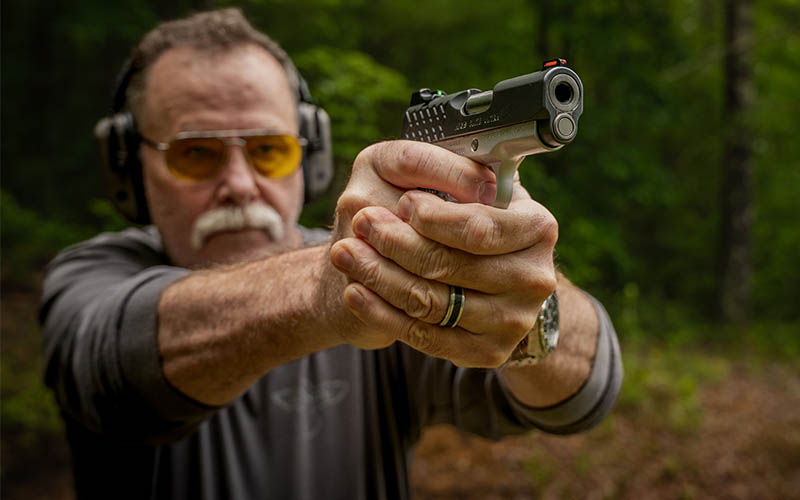
After alternating these two pistols through the drill, I then fired the drill three times with the 5-inch Ronin for an average time of 2.83 seconds. Based on this test, when conducting multi-shot/multi-target drills at about 10 yards, the 3-inch 1911s were about 10 percent slower than a 5-inch 1911.
Precision Shooting
The second shooting test was a reduced version of what I call the Step Back Drill. In this drill, you fire two shots at an 8-inch target from 5, 10 and 15 yards, timing each two-shot string separately. After completing all six shots in the drill, you add up your times at each distance for a total. A good par time for all six shots is something less than 9 seconds.
I ran this drill six times with each of the three pistols to establish an average. My thinking was that this drill would show how good, or bad, a 3-inch 1911 might perform at various distances given the handicap of its shorter sight radius. The 8-inch target required more precise shot placement than the full-size torso targets.
Between the 3-inch guns, I shot minutely better on this drill with the Kimber Aegis Ultra, but only out to 10 yards. At 15 yards, I shot better with the Springfield Ronin. Both pistols had very similar sights, and both triggers broke right at 4 pounds.
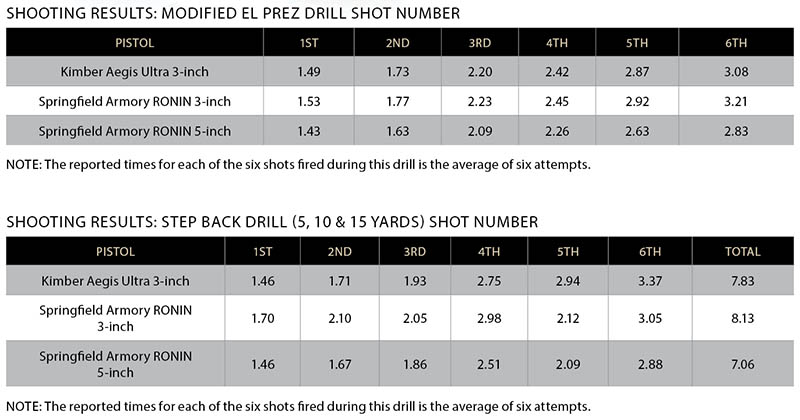
Again, I think the difference at the closer distances was the thicker grip on the Kimber because I was running the gun faster. At 15 yards, I had to slow down a bit, and the thinner grip on the 3-inch Springfield wasn’t a handicap … but why it averaged better at 15 yards I have no idea. (This is, of course, one reason tests like this can be important; you can discover how you interact with different guns differently in different situations.) As expected, I shot a bit better with the 5-inch Ronin because of its longer sight radius and less recoil. On average, the 5-inch pistol was about 11 percent faster.
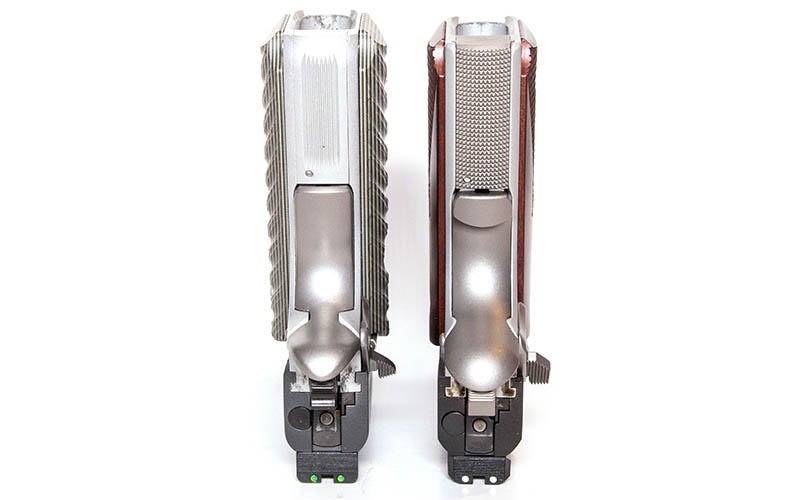
Advantages/Disadvantages
Clearly, the more compact and lighter 3-inch 1911s are easier to carry—and that’s important. The more comfortable a pistol is to carry, the more likely you are to have it with you when you need it. Arguably, that might very well offset any shooting advantage the 5-inch 1911 offers. The 3-inch Kimber only had a seven-round magazine, but the Springfield Ronin had a nine-round magazine, which was the same capacity as the 5-inch Springfield, and it was surprisingly extremely easy to load. The magazines for the Kimber and the Springfield 3-inch guns weren’t interchangeable.
Before I ran the drills for record, I fired 100 rounds of Federal’s 124-grain Tactical Hydra-Shok load through each of the three pistols, just so I was familiar with them. The good news is that I didn’t experience any reliability issues with either of the 3-inch guns, which is something they are commonly accused of having. I did have one stoppage, and ironically, it was with the 5-inch gun. At round 97, one cartridge failed to go fully into battery, and a slight tap on the back of the slide solved the problem.
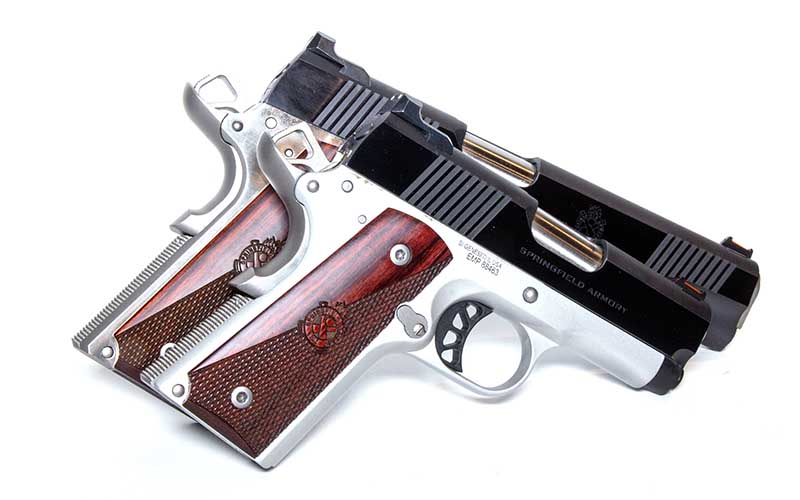
You can expect to shoot better with the full-size 1911, and that shouldn’t come as a surprise to anyone. One thing I’ve heard over the years is that the shorter-barreled 1911s are quicker to get out of the holster. That makes sense, but getting a gun out of the holster a few milliseconds faster must also be measured with the speed at which you can get it on target. Considering all the drills at all distances, on average I was able to get a first hit from the holster with the 3-inch guns in 1.90 seconds. With the 5-inch 1911, I was able to secure a first-round hit from the holster in 1.71 seconds. Again, that’s about a 10 percent advantage for the larger 1911. The little guns might escape the holster faster, but the longer sight radius of the longer-barreled 1911 allows the sights to find the target sooner.
I think both the Kimber Aegis Elite Ultra and the Springfield Ronin are nice pistols, and they are a joy to carry. The Kimber costs a bit more, but I shot it a bit better and it’s probably the gun I would go with. You must decide if a 10 percent advantage in shootability is worth the added discomfort of carrying a pistol that’s 50 percent heavier and 25 percent larger.
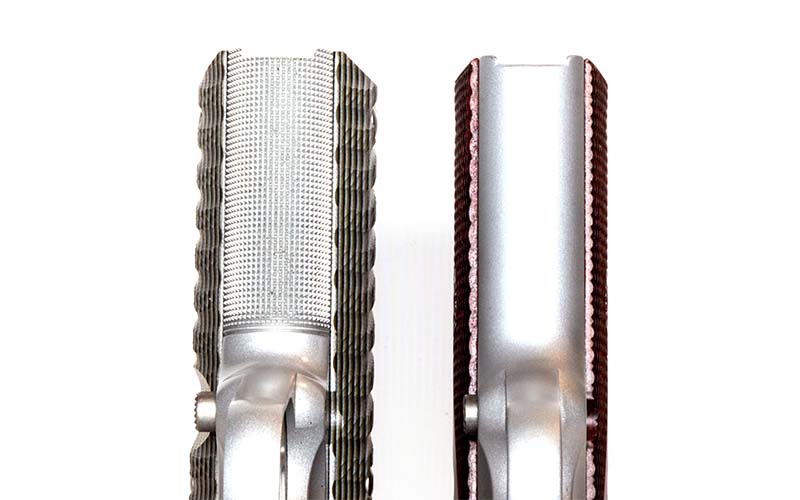
And, at the risk of kicking a dead horse: I’ll say again that the ease of carry of these 3-inch 1911s might make all the difference in the end. Self-defense handguns are worthless when they’re left at home.
Though he didn’t sing a thing about guns, it appears that as Alan Jackson so eloquently put it, “It’s alright to be little bitty.”
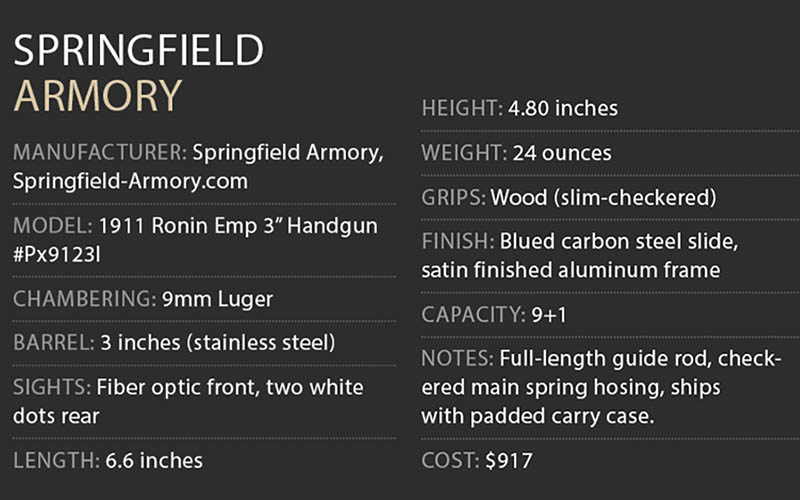
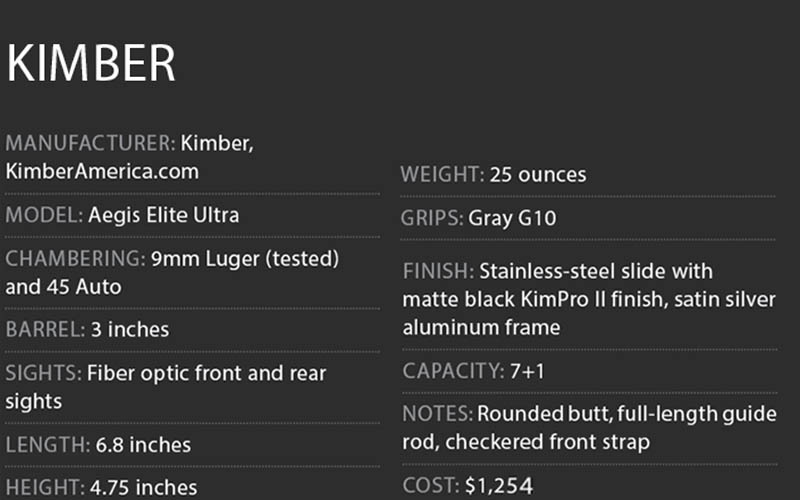
Editor's Note: This article originally appeared in the 2023 Buyer's Guide special issue of Gun Digest the Magazine.
More Handgun Reviews:
- Beretta 80X Cheetah: Good Kitty Or Damn Pity?
- The Bull’s Eye: Taurus 856 Defender T.O.R.O. Review
- The Big Snake Is Back: 2021 Colt Anaconda Review
- Completely Customizable: Sig P320 Review
- Turkish Take On The Czech Classic: SAR 2000 Review

Next Step: Get your FREE Printable Target Pack
Enhance your shooting precision with our 62 MOA Targets, perfect for rifles and handguns. Crafted in collaboration with Storm Tactical for accuracy and versatility.
Subscribe to the Gun Digest email newsletter and get your downloadable target pack sent straight to your inbox. Stay updated with the latest firearms info in the industry.

![Best Concealed Carry Guns In 2025 [Field Tested] Wilson Combat EDC X9S 1](https://gundigest.com/wp-content/uploads/Wilson-Combat-EDC-X9S-1-324x160.jpg)


![Best 9mm Carbine: Affordable PCCs [Tested] Ruger Carbine Shooting](https://gundigest.com/wp-content/uploads/Ruger-Carbine-Shooting-100x70.jpg)
![Best AR-15: Top Options Available Today [Field Tested] Harrington and Richardson PSA XM177E2 feature](https://gundigest.com/wp-content/uploads/Harrington-and-Richardson-PSA-XM177E2-feature-100x70.jpg)

I really appreciated Mr. Mann’s review as I have owned a Ronin for over a year and plan to use it when I get around to applying for a CCW license. I would have enjoyed a comment about recoil, but I am familiar with full power .357 loads out of a 34-oz. Security Six, so I am ready for the Ronin regardless of its recoil. Reliability is my obsession when it comes to self-defense with a semiauto. I would think a very similar article using two double action only snub .38 specials would be just as valuable, perhaps more so since the snub is so popular for concealed carry.